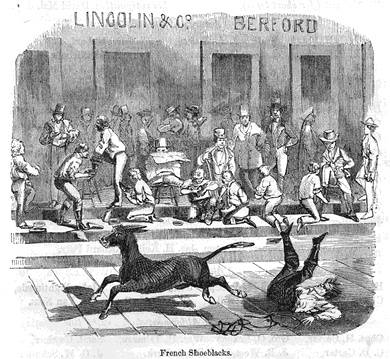French Inhabitants 1853
Primary Source
Annals of San Francisco, 1855
French Shoeblacks at work.
SEPTEMBER 19th, 1853: The French inhabitants of the city organized themselves the "Lafayette Hook and Ladder Company." The uniform they adopted was that common to firemen in France. We have at different places alluded to the public spirit of this class of citizens, and their appearance in large bodies on occasions of public ceremonial. They are nearly as numerous as the Germans in San Francisco, and may now (1854) number about 5,000 persons of both sexes. They preserve many characteristics, and do not seem capable of thoroughly adopting American thoughts and fashions. But a small proportion seek to become naturalized citizens, and they do not readily acquire our language.
California, and America itself, are but places where money may be made to enable them to return to their own land in Europe. In San Francisco they have monopolized many professions of a semi-artistic character. They are chief shoeblacks and hairdressers, cooks, wine importers and professional gamblers. In the first-named capacity, they form one of the street features of the place. They are posted at many, of the prominent corners, with seats for their customers, whose boots they are ever ready to polish at the charge of twenty-five cents; and some of them have at this singular business gathered money enough to open shops, neatly furnished, for the same purposes. It is not uncommon to see a dozen of these shoeblacks in a row upon the edge of the sidewalks, scouring and scrubbing away at the muddy or dusty boots of their patrons. But besides these occupations, this people pursue all other callings here, and many of them are among the most distinguished, wealthy and respectable inhabitants of the city. They are partial to public amusements, and have often a theatre open, where plays, vaudevilles and operas in their own language are performed. They have a society for the relief of poor immigrants, besides several other benevolent associations. Two tri-weekly newspapers are published in their language, a portion of one of which is written in Spanish.
The presence of the French has had a marked influence upon society in San Francisco. Skilled workmen of their race have decorated the finer shops and buildings, while their national taste and judicious criticism have virtually directed the more chaste architectural ornaments, both on the exterior and in the interior of our houses. Their polite manners have also given an ease to the ordinary intercourse of society which the unbending American character does not naturally possess. The expensive and fashionable style of dressing among the French ladies has greatly encouraged the splendid character of the shops of jewellers, silk merchants, milliners and others whom women chiefly patronize, while it has perhaps increased the general extravagance among the whole female population of the city.
There are in San Francisco many natives of Switzerland and Alsace, those debatable lands between the French and German people. The Alsatians are claimed, and sometimes rejected by both. There does not seem much sympathy between the rival races, less a great deal than is between either of them and the Americans. The French complain that they are not treated so kindly by the last as are the Germans. The reason seems obvious. It is because they do not take the same pains to learn the American language and character. The naturalized Germans are professed and acknowledged brethren; the French--foreign in manner and physical appearance, in thoughts and hopes--can never be considered as such. The occasional devotion of Germans to old Fatherland does not so fill their hearts that they become insensible to the numberless political and social blessings which they receive in their adopted country.
But the wild glorification of Frenchmen to every thing connected with their beautiful France is often a neglectful insult to the land that shelters them, and which they would ignore, even although they seek not to become its permanent citizens. Both races have played a prominent part in the industrial history of San Francisco, and in that of California generally. Their numbers are very large in the various mining districts; while, as we have seen, they form a considerable proportion of the population of the city. They are not the dominant spirits of the place--for these are of the true American type that ever cry go ahead !--but they help to execute what the national lords of the soils, the restless and perhaps unhappy people of progress contrive. The character of a man may at least partially be inferred from his "drinks." The true Germans dote on lager-bier--and they are a heavy, phlegmatic, unambitious race; the French love light wines--and they are as sparkling, yet without strength or force of character; the genuine Yankee must have a burning spirit in his multitudinous draughts--and he is a giant when he begins to work, tearing and trampling over the impossibilities of other races, and binding them to his absolute insolent will.

